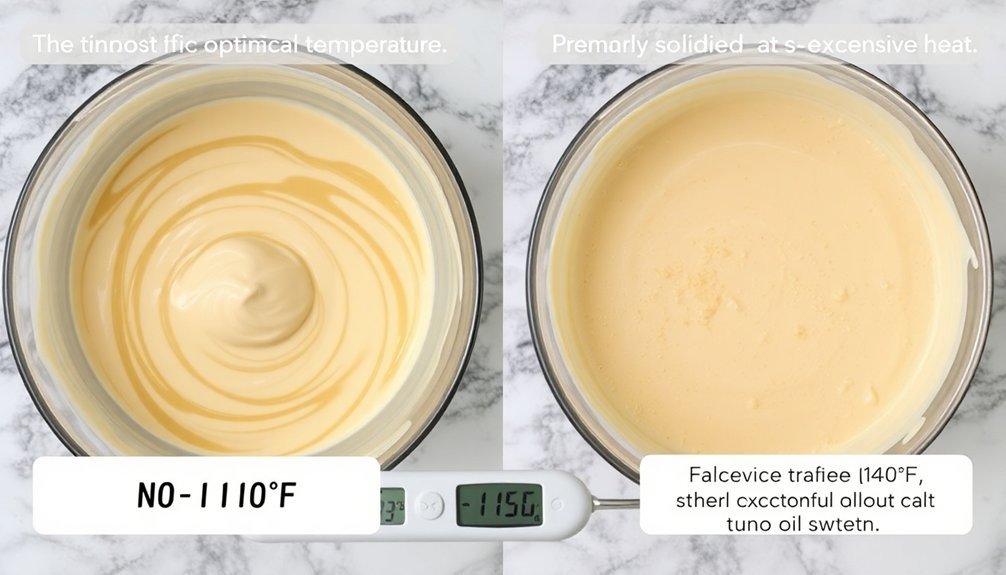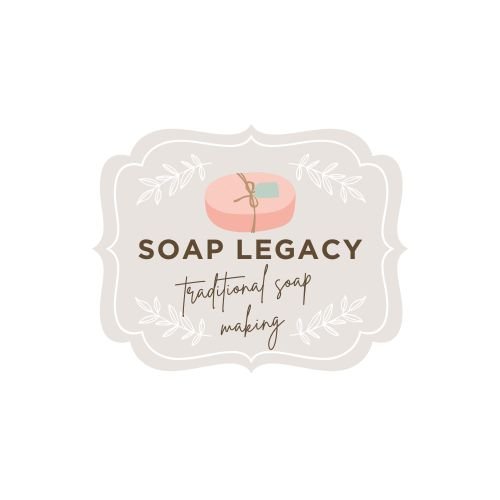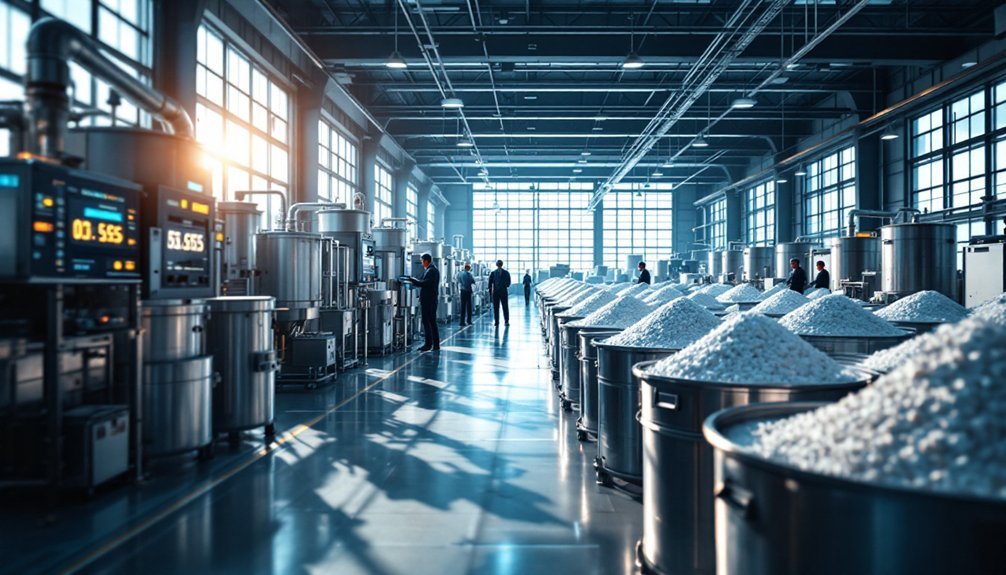Temperature control is the make-or-break factor in soap making. Keep your oils and lye solution between 120-130°F for best results. Too hot causes acceleration, volcanoes, and cracking; too cold leads to false trace with grainy texture and poor bonding. Proper temperature management guarantees silky-smooth soap with perfect texture and color vibrancy. Whether you're using heat transfer methods or careful monitoring, mastering this fundamental aspect will transform your soap crafting from unpredictable to consistently professional.
How Temperature Makes or Breaks Your Soap

When crafting handmade soap, temperature control isn't just helpful—it's crucial to your success. Maintaining a soaping temperature between 120-130°F for both oils and lye solution creates the perfect environment for proper saponification without triggering false trace or accelerating the process too quickly.
You'll notice that mixing at temperatures above 110°F can compromise soap quality, even if it seems to speed up trace. Always verify your oils are clear, not cloudy, which indicates solidified fatty acids that might disrupt your batch.
Temperature management affects everything from workability to final appearance. Too hot? You risk glycerin rivers or separation. Too cool? Expect soda ash or texture issues.
This is especially critical with low water soap recipes, which react more intensely to temperature fluctuations than high water soaps do.
The Science Behind Soap Temperatures: Why It Matters

The chemical reactions behind soap making explain why temperature control is so essential to your success. When lye to water meets soap making oils, saponification begins—a process highly sensitive to heat. At 120-130°F, you'll achieve ideal conditions where oils remain liquid while trace occurs at a manageable pace.
Temperature management directly impacts soap quality. Too hot (above 110°F), and you'll face accelerated reactions, potentially causing cracking or "alien brain" formation.
Too cold, and your oils may solidify upon contact with lye.
The gel phase—which enhances color vibrancy—requires sufficient heat to activate. This becomes especially vital when working with high-water recipes or heat-sensitive additives like milk.
Using a temperature gun to monitor your ingredients before pouring into soap molds helps prevent common issues like soda ash and glycerin rivers.
Cold Process Temperature Guidelines: Finding Your Sweet Spot

Although many soapers develop personal preferences over time, successful cold process soap making typically requires maintaining both oils and lye solution between 120-130°F for ideal results. This temperature range promotes proper saponification while preventing false trace, which occurs when oils solidify prematurely rather than actually reacting with lye.
You'll want to keep your oils and lye within 10 degrees of each other when mixing to guarantee a smooth, consistent reaction. Room temperature works fine for liquid oils, but hard oils and butters need thorough melting.
Be cautious of temperatures below 100°F, which may cause soda ash formation, or above 140°F, which can trigger gel phase. While gel phase intensifies colors, it requires careful monitoring to avoid defects like alien brain formation in your finished soap.
Hot Process Temperature Management for Perfect Results

While cold process soap relies on careful temperature control for gradual saponification, hot process soap making turns up the heat—literally.
You'll want to start by warming and melting your oil mixture directly in the cooking pot before adding lye, which accelerates the saponification reaction considerably.
Unlike cold process methods, you don't need to cool your lye solution first. In fact, you can add it at temperatures up to 200°F, though maintaining 120-130°F yields ideal results.
Keep your oils and lye temperatures within 10 degrees of each other to prevent separation and guarantee a smoother texture.
Careful temperature management is essential throughout the process. Monitoring temperature helps you avoid soap defects like alien brain formation or soap volcanoes from overheating, while also preventing stalled saponification if temperatures drop below the melting point of your oils.
Preventing False Trace: Temperature's Critical Role

Because temperature directly impacts the consistency of your soap batter, understanding false trace becomes essential for soapmakers aiming for quality results.
False trace occurs when your soap batter prematurely thickens in cool temperatures, misleading you into thinking it's ready when it's not.
To avoid this frustrating issue, guarantee your oils are fully melted and clear at the ideal soaping temperature of 120-130°F.
Cloudiness indicates solidified fatty acids that can derail your process.
Keep your lye solution around body temperature (98.6°F) and maintain oil temperatures within 10 degrees of your lye temperature to promote proper saponification.
If you encounter false trace, continue mixing until saponification generates enough heat to remelt any solidified fats.
This persistence restores proper consistency and salvages your batch.
The Heat Transfer Method: Simplifying Your Soap Making Process
Medium heat offers you the perfect balance for successful soap making, allowing oils to melt evenly without damaging delicate ingredients.
You'll find that maintaining this gentle warmth throughout your process prevents hot spots that can cause partial gel phases or uneven saponification.
When using the Heat Transfer Method, these benefits become even more pronounced as the heat from your lye solution efficiently melts your oils while maintaining a consistent temperature throughout the batch.
Medium Heat Benefits
When you're looking to streamline your soap making process, the Heat Transfer Method offers an elegant solution by harnessing the natural heat from your lye solution.
By maintaining medium heat with oil temperatures between 120-130°F, you'll prevent the grainy texture that occurs when solid oils resolidify prematurely.
This approach works exceptionally well with soap recipes containing soft or liquid oils, as it guarantees everything remains fully melted before combining with your lye solution.
Aim to cool your lye solution to around body temperature (98-104°F) for the most consistent mixture.
The beauty of this method lies in its efficiency—you're using the naturally generated heat to facilitate the saponification process rather than relying on external heating sources.
The result? A smoother, more controlled soap making experience with less equipment and fewer temperature fluctuations to manage.
Avoiding Hot Spots
Despite its many advantages, the Heat Transfer Method requires careful attention to prevent hot spots that can compromise your soap's quality. When using this technique in soap making, you'll need to monitor temperatures carefully, keeping both your oils and lye solution within 10 degrees of each other, ideally around 120-130°F for ideal results.
Start by weighing your solid oils and butters in your container before adding the hot lye solution. The heat from the solution will gradually melt these ingredients. Stir gently until you've achieved a consistent mixture, which gives you better control over the saponification process.
This methodical approach prevents overheating and eliminates hot spots that could lead to unwanted textures like alien brain or glycerin rivers. The Heat Transfer Method works especially well with soft and liquid oils, resulting in smoother, more uniform soap.
Mastering the Gel Phase Through Temperature Control
Throughout the soap-making process, understanding and controlling temperature becomes essential for achieving the desired gel phase. When your soap reaches 120-130°F, the gel phase activates, enhancing color vibrancy and maximizing saponification. You'll notice your soap retains moisture more effectively during this vital change.
You can manage this phase by monitoring your lye solutions and base oils carefully. Higher temperature environments naturally promote gelling, while a lower temp approach might require insulation to reach the ideal 140-150°F for full gel. Be cautious of overheating beyond this range, which can cause alien brains or glycerin rivers in your final product.
Consider your recipe's water content when planning proper thermal management. Higher water soaps may need external heat, while low-water formulations gel more predictably.
Remember that additives like honey or milk can greatly affect heat generation during saponification.
Frequently Asked Questions
How Does Temperature Affect Soap?
Temperature affects your soap by determining proper saponification, texture, and appearance. You'll get better results keeping oils and lye between 120-130°F. Too hot causes defects, while too cold leads to false trace or soda ash.
What Causes Soap to Break?
Your soap can break when temperatures are too extreme during mixing. If you're using lye that's too cold or overheating during saponification, you'll see cracks, alien brain formations, or grainy textures appearing.
What Happens When Soap Is Heated?
When you heat soap, it enters gel phase, enhancing colors but risking defects like alien brains or volcanoes. You'll see glycerin rivers, puffiness, or cracks if temperatures climb too high during saponification.
How to Prevent Soap From Overheating?
To prevent soap from overheating, you'll need to monitor temperature closely (120-130°F), use lower lye concentration, implement cooling methods like fans, minimize insulation, and experiment with smaller batches or adjusting water content in your recipe.
In Summary
You've now discovered how temperature governs every aspect of your soapmaking journey. Whether you're working with cold process, hot process, or exploring gel phase, your temperature management skills directly impact your soap's quality. By understanding these thermal principles, you'll prevent common issues like false trace and create consistently beautiful bars. Trust your thermometer, respect the science, and you'll transform your soapmaking from unpredictable to masterful.





Leave a Reply